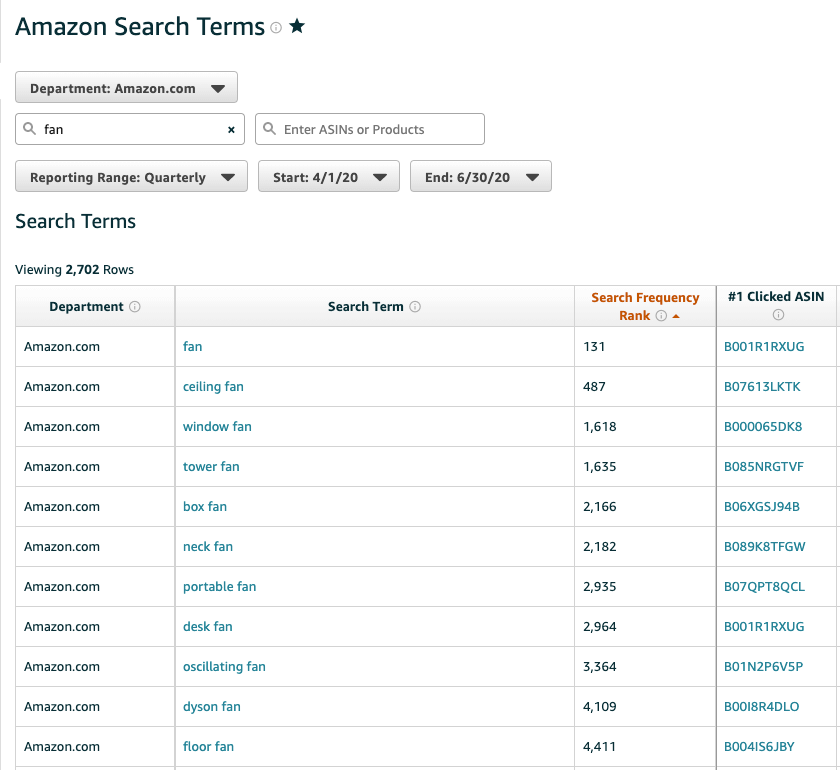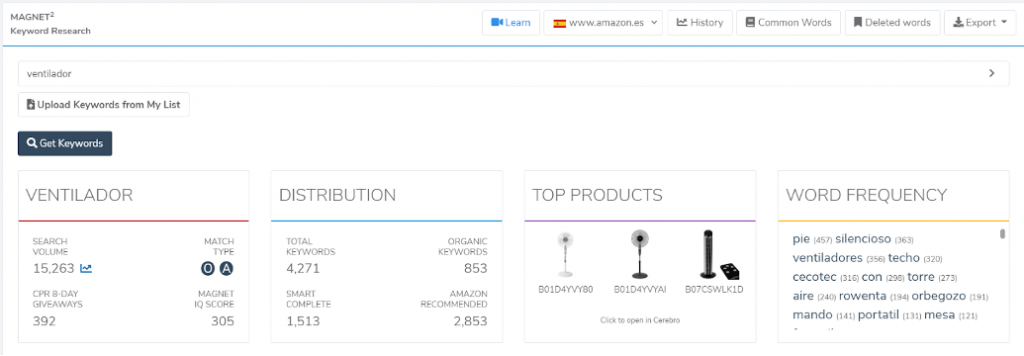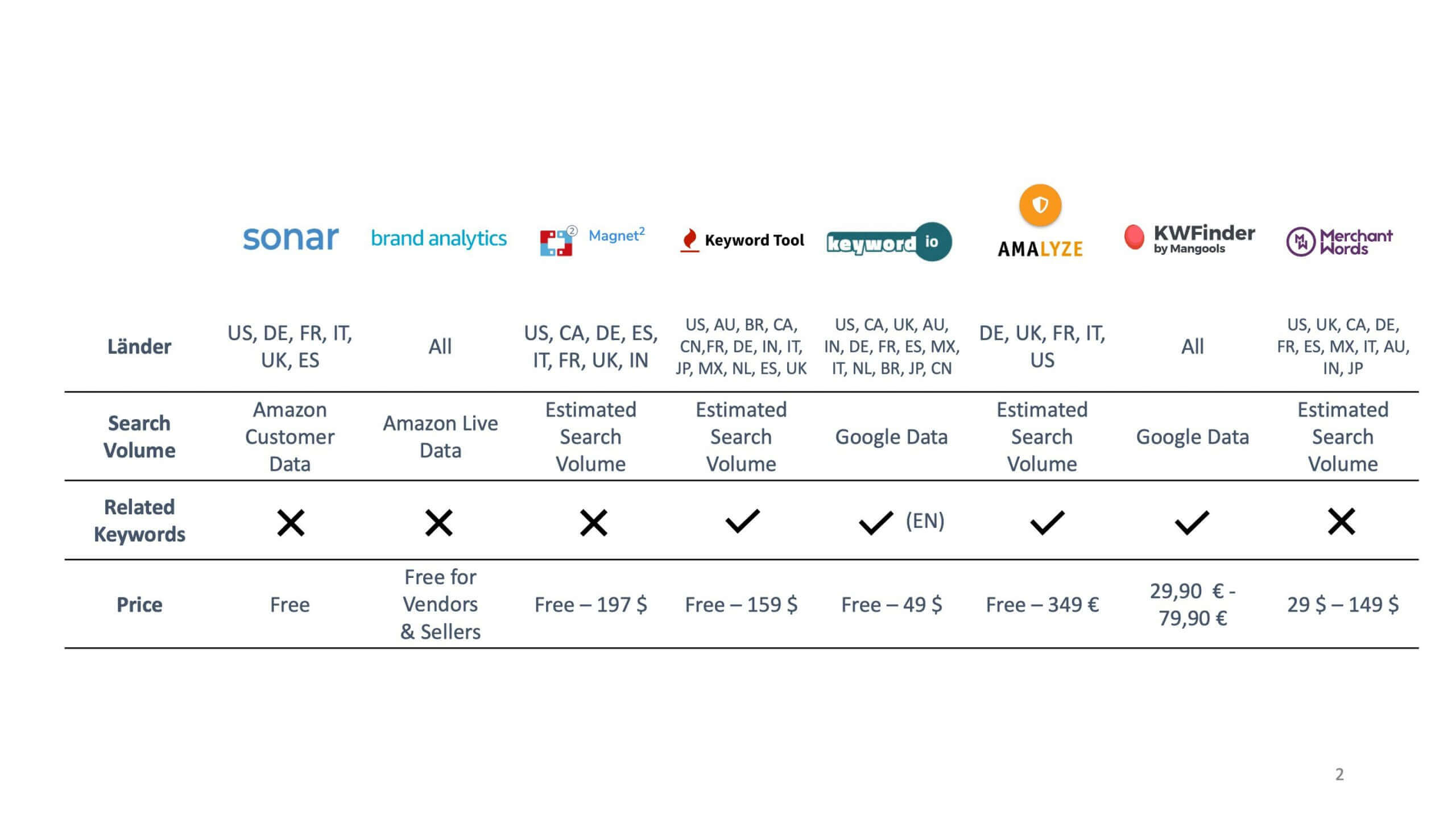
Optimising content for Amazon: Which is the best keyword tool?

It‘s getting warmer and the prospect of a hot summer is driving many people online in search of ways to cool off. If you want to buy an air conditioner, you might start your search on Google and find out about the differences and advantages.
Suppose we sell a fan with the dashing name “Windspeed” on Amazon: This product name has little to do with how the customer speaks. So, if we do not have the term fan in our product text, we are unlikely to be found by that customer. That is why we create SEO content.
Keyword tools help us to find terms that reflect the customer’s language and are the words actually searched for. Because not only the customer but also the algorithm must understand what kind of product it is. The trick is to integrate the keywords into the text in such a way that it remains attractive and readable. But before there can even be a text into which the keywords are integrated, they must first be researched. There are numerous tools available, many of which are even specially designed for Amazon. We want to show you what you need to pay attention to in order to find the right tool for you.
Welcome to the jungle of Amazon keyword tools
If you google “Amazon Keyword Tool”, you will get many hits. All tools advertise having the most reliable data and features, but at first glance they all look quite similar. So we took a closer look to find out which features make a tool stand out from the crowd.
A reliable database is crucial
The search volume is one of the most important information and is basically given by all tools. Nevertheless, it is a decisive quality criterion, because not all tools determine the search volume in the same way: The real search volumes on Amazon are a well-kept secret. Some tools base their figures on mere estimates or take data from Google. Although certain trends can certainly be readily identified from Google data, consumer behaviour on Amazon is different, as many search queries on Google are made without any specific intention to make a purchase.
Who can do it?
One of the few tools that offers largely reliable data is Sonar from Sellics, for example. Although less relevant keywords are updated irregularly and are only displayed as a ranking from 1 to 5, real customer data, and no other sources, are used for calculation.

Another tool, which is even free of charge for sellers and vendors, is Amazon’s Brand Analytics: It does not display search volumes, but rankings, which can be filtered by day, week, month or quarter. Since this data is provided directly by Amazon, it is one of the most reliable sources you can find.
Know the competition
An interesting feature that can make a tool stand out from the crowd is the backward search via ASIN, as this way competing products can be analysed. Some tools make this function particularly clear, with images and a structured layout.
Who can do it?
In addition to Brand Analytics, which presents the top 3 clicked ASINs, the premium tool Magnet² from Helium 10 is also available, where a click on one of the top products is enough to analyse competing brands with Cerebro. In addition, Helium 10 offers some interesting metadata that is not only interesting for SEO but also for campaigns. For example, how many products appear in the search results for a specific keyword and how many of them had current or recently active sponsored ads.

Subscribe to our newsletter now and receive regular updates on Amazon and other online marketplaces.
Subscribe to the newsletter now.

Expanding the spectrum
Some databases, such as Keywordtool.io‘s, consist only of auto-suggests from the Amazon search bar. Thus, only compound keywords are found, but no synonyms or related search terms. Although this is useful for forming longtail keywords, it does not lead to differentiated results. The more filter options a tool has, the wider the result spectrum and the higher the quality of the SEO text. After all, who wants to read a text that constantly mentions a “men’s razor” or “beard razor”?
Who can do it?
In addition to related search terms, tools such as Keyword.io or Sonar also offer the possibility of excluding negative keywords, such as competitor brand names. Amalyze Shield, among others, can hold its own in this regard. It also shines with another interesting feature that we haven’t found in any other tool so far: The misspellings placed in the search terms are increasingly losing relevance as Amazon’s auto-suggest function not only suggests extended, but also corrected keywords. During the research, Shield shows which keywords Amazon suggests to customers instead. However, since persistent misspellings often still rank highly, they should not be completely disregarded yet.

Another interesting filter is the search by category, offered by Merchant Words, Keywordtool.io or Brand Analytics, among others: This can be useful if a keyword appears in several categories, e.g. coconut oil as an ingredient in cosmetics and food, or simply to focus the result list on a specific focus.
How do I find the best Amazon keyword tool for me?
The large number of Amazon Keyword Tools makes an unrestricted recommendation hardly possible. Depending on individual needs, requirements and the available budget, different tools can be “the right one”. With the features described above, however, the choice can be narrowed down considerably. Finally, we would like to give you some tips that can shorten the search considerably. In the run-up to the search you have to be clear about what exactly the tool should be able to do.

With prices of up to around 200 USD per month, it is not least a question of budget when choosing which tool and premium model to choose.
Many tools are less focused on SEO, but more on Amazon Advertising and campaign management. If you are looking for an Amazon SEO tool, you should carefully consider whether you need these features, especially if you are looking at more expensive, premium tools. Although most tools also offer a free version, this is usually very limited and hardly suitable for qualitative search engine optimisation.
It can also be worthwhile to take a look at tools that are not specifically designed for Amazon: KWFinder is a remarkable competitor to Google Keyword Planner. Although the search volume indicated is partly inaccurate, since it is formed from combined keyword groups, the figures do not refer to Amazon anyway. Instead, you will find a large number of useful synonyms and related search terms for all languages, which can be used for further research in an Amazon-specific tool.
However, we consider a reliable database and a differentiated selection of keywords and synonyms to be essential for creating high-quality SEO content. If no all-rounder tool can be found, a combination of several tools can be used. For example, one to find a wide range of synonyms and combinations and another to determine the search volume.
We hope that we could give you a small overview of what is important when making a decision, so that you can find your way through the keyword tool jungle to the perfect SEO content more easily.
Are you interested in an expert analysis of your Amazon account?
Request free analysisRelated articles
Remazing GmbH
Brandstwiete 1
20457 Hamburg
©Remazing GmbH




